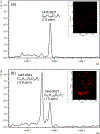On-Tissue Derivatization of Lipopolysaccharide for Detection of Lipid A Using MALDI-MSI
- PMID: 32902263
- PMCID: PMC8717242
- DOI: 10.1021/acs.analchem.0c02566
On-Tissue Derivatization of Lipopolysaccharide for Detection of Lipid A Using MALDI-MSI
Abstract
We developed a method to directly detect and map the Gram-negative bacterial virulence factor lipid A derived from lipopolysaccharide (LPS) by coupling acid hydrolysis with matrix-assisted laser desorption/ionization mass spectrometry imaging (MALDI-MSI). As the structure of lipid A (endotoxin) determines the innate immune outcome during infection, the ability to map its location within an infected organ or animal is needed to understand localized inflammatory responses that results during host-pathogen interactions. We previously demonstrated detection of free lipid A from infected tissue; however detection of lipid A derived from intact (smooth) LPS from host-pathogen MSI studies, proved elusive. Here, we detected LPS-derived lipid A from the Gram-negative pathogens, Escherichia coli (Ec, m/z 1797) and Pseudomonas aeruginosa (Pa, m/z 1446) using on-tissue acid hydrolysis to cleave the glycosidic linkage between the polysaccharide (core and O-antigen) and lipid A moieties of LPS. Using accurate mass methods, the ion corresponding to the major Ec and Pa lipid A species (m/z 1797 and 1446, respectively) were unambiguously discriminated from complex tissue substrates. Further, we evaluated potential delocalization and signal loss of other tissue lipids and found no evidence for either, making this LPS-to-Lipid A-MSI (LLA-MSI) method, compatible with simultaneous host-pathogen lipid imaging following acid hydrolysis. This spatially sensitive technique is the first step in mapping host-influenced de novo lipid A modifications, such as those associated with antimicrobial resistance phenotypes, during Gram-negative bacterial infection and will advance our understanding of the host-pathogen interface.
Figures


Similar articles
-
Micromethods for Isolation and Structural Characterization of Lipid A, and Polysaccharide Regions of Bacterial Lipopolysaccharides.Methods Mol Biol. 2017;1600:167-186. doi: 10.1007/978-1-4939-6958-6_16. Methods Mol Biol. 2017. PMID: 28478567
-
Enhanced capabilities for imaging gangliosides in murine brain with matrix-assisted laser desorption/ionization and desorption electrospray ionization mass spectrometry coupled to ion mobility separation.Methods. 2016 Jul 15;104:69-78. doi: 10.1016/j.ymeth.2016.02.014. Epub 2016 Feb 23. Methods. 2016. PMID: 26922843
-
Nitrogen and Sulfur Co-doped Carbon-Dot-Assisted Laser Desorption/Ionization Time-of-Flight Mass Spectrometry Imaging for Profiling Bisphenol S Distribution in Mouse Tissues.Anal Chem. 2018 Sep 18;90(18):10872-10880. doi: 10.1021/acs.analchem.8b02362. Epub 2018 Sep 5. Anal Chem. 2018. PMID: 30139256
-
Mass spectrometry advances in lipidomica: collision-induced decomposition of Kdo2-lipid A.Prostaglandins Other Lipid Mediat. 2005 Sep;77(1-4):131-40. doi: 10.1016/j.prostaglandins.2004.09.004. Prostaglandins Other Lipid Mediat. 2005. PMID: 16099398 Free PMC article. Review.
-
Surface analysis of lipids by mass spectrometry: more than just imaging.Prog Lipid Res. 2013 Oct;52(4):329-53. doi: 10.1016/j.plipres.2013.04.005. Epub 2013 Apr 24. Prog Lipid Res. 2013. PMID: 23623802 Review.
Cited by
-
Uncovering lipid dynamics in Staphylococcus aureus osteomyelitis using multimodal imaging mass spectrometry.Cell Chem Biol. 2024 Oct 17;31(10):1852-1868.e5. doi: 10.1016/j.chembiol.2024.09.005. Epub 2024 Oct 9. Cell Chem Biol. 2024. PMID: 39389064
-
Structural determination of Rickettsia lipid A without chemical extraction confirms shorter acyl chains in later-evolving spotted fever group pathogens.mSphere. 2024 Feb 28;9(2):e0060923. doi: 10.1128/msphere.00609-23. Epub 2024 Jan 23. mSphere. 2024. PMID: 38259062 Free PMC article.
-
Rapid MALDI-MS/MS-Based Profiling of Lipid A Species from Gram-Negative Bacteria Utilizing Trapped Ion Mobility Spectrometry and mzmine.Anal Chem. 2025 Apr 15;97(14):7781-7788. doi: 10.1021/acs.analchem.4c05989. Epub 2025 Apr 1. Anal Chem. 2025. PMID: 40167996 Free PMC article.
-
Bacterial biofilm sample preparation for spatial metabolomics.Analyst. 2025 Jul 21;150(15):3257-3268. doi: 10.1039/d5an00466g. Analyst. 2025. PMID: 40625053 Free PMC article. Review.
-
DMEM and EMEM are suitable surrogate media to mimic host environment and expand leptospiral pathogenesis studies using in vitro tools.bioRxiv [Preprint]. 2025 Jan 24:2025.01.22.634353. doi: 10.1101/2025.01.22.634353. bioRxiv. 2025. PMID: 39896660 Free PMC article. Preprint.
References
-
- Castellino S; Groseclose MR; Wagner D Bioanalysis 2011, 3 (21), 2427–2441. - PubMed
-
- Schulz S; Becker M; Groseclose MR; Schadt S; Hopf C Curr. Opin. Biotechnol 2019, 55, 51–59. - PubMed
-
- Amstalden van Hove ER; Smith DF; Heeren RMA Journal of Chromatography A 2010, 1217 (25), 3946–3954. - PubMed
-
- Cornett DS; Reyzer ML; Chaurand P; Caprioli RM Nat. Methods 2007, 4 (10), 828–833. - PubMed
Publication types
MeSH terms
Substances
Grants and funding
LinkOut - more resources
Full Text Sources
Research Materials

